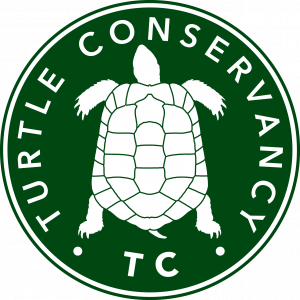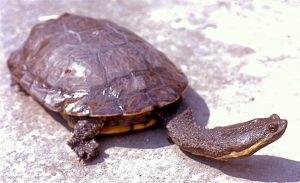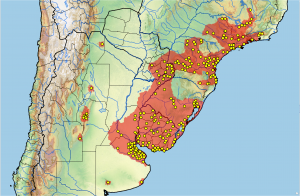Hydromedusa tectifera, 113
Hydromedusa tectifera Cope 1870 –
South American Snake-necked Turtle,
Argentine Snake-necked Turtle, Tortuga Cuello de Vibora, Cágado Pescoço de Cobra
Leandro Alcalde1, Rocio Maria Sánchez1, and Peter C.H. Pritchard2
1Instituto de Limnología Dr. R. A. Ringuelet – Centro Científico Tecnológico, La Plata,
Consejo Nacional de Investigaciones Científicas y Tecnológicas (CC712 – CP1900),
Boulevard 120 y 62 s/n, La Plata, Buenos Aires, Argentina [[email protected]; [email protected]];
2Chelonian Research Institute, Oviedo, Florida 32765 USA [Deceased]
Summary. – The South American Snake-necked Turtle, Hydromedusa tectifera (Family Chelidae), is a medium-sized freshwater turtle, found in southern Brazil, Uruguay, southern Paraguay, and east and central Argentina. Maximum recorded straight carapace length (CL) is 30.6 cm in females and 28.4 cm in males, although most individuals are usually less than 25.0 cm. Its skull and carapace structure show characters quite distinct from those of the superficially similar chelid snake-necked turtles of Australia (genus Chelodina). Clutch size is 5–15 eggs and eggs are elongate, ranging from ca. 24–40 x 20–24 mm; hatchlings have a CL of ca. 35–37 mm. Preferred habitats for H. tectifera consist primarily of natural lentic and lotic waters, including anthropogenically altered or constructed habitats (e.g., creeks, dams, lakes, lagoons, streams, rivers, and coastal estuaries). The species is specialized for feeding upon a wide spectrum of food items, mainly aquatic arthropods. The international pet trade in this species is modest, and although it seems to be affected by industrial and agricultural pollution in several parts of the range (e.g., Rio de Janeiro State in Brazil, Buenos Aires Province in Argentina), it shows considerably greater tolerance for polluted conditions than does its congener H. maximiliani.
Distribution. – Central and northeastern Argentina (Buenos Aires, Córdoba, Entre Ríos, Misiones, Santa Fe, Salta, San Luis, Santiago del Estero), southern Brazil (Minas Gerais, Paraná, Rio de Janeiro, Rio Grande do Sul, Santa Catarina, São Paulo), southeastern Paraguay (Alto Paraná, Itapuá, Guairá), and most of Uruguay.
Synonymy. – Hydromedusa tectifera Cope 1870, Hydromedusa platanensis Gray 1873, Hydromedusa platensis, Platemys antiqua ? Ameghino 1882 (nomen nudum), Platemys fossilis ? Ameghino 1882 (nomen nudum), Platemys laevis ? Ameghino 1882 (nomen nudum), Platemys robusta ? Ameghino 1882 (nomen nudum), Hydromedusa wagleri Günther 1884.
Subspecies. – None currently recognized.
Status. – IUCN 2021 Red List: Least Concern (LC) [Not Listed] (TFTSG 1996); TFTSG Provisional Red List: Least Concern (LC; assessed 2011); CITES: Not Listed; U.S. ESA: Not Listed.
Citation:
Alcalde, L., Sánchez, R.M., and Pritchard, P.C.H. 2021. Hydromedusa tectifera Cope 1870 – South American Snake-necked Turtle, Argentine Snake-necked Turtle, Tortuga Cuello de Vibora, Cágado Pescoço de Cobra. In: Rhodin, A.G.J., Iverson, J.B., van Dijk, P.P., Stanford, C.B., Goode, E.V., Buhlmann, K.A., and Mittermeier, R.A. (Eds.). Conservation Biology of Freshwater Turtles and Tortoises: A Compilation Project of the IUCN/SSC Tortoise and Freshwater Turtle Specialist Group. Chelonian Research Monographs 5(15):113.1–17. doi: 10.3854/crm.5.113.tectifera.v1.2021; www.iucn-tftsg.org/cbftt/.
Download pdf
Adobe Acrobat 6.0 or later required)
Adult Hydromedusa tectifera from Brazil.
Photo by Peter C.H. Pritchard.
Distribution:
Distribution of Hydromedusa tectifera in southern South America in Argentina, Brazil, Paraguay, and Uruguay. Yellow dots = museum and literature occurrence records of native populations based on Iverson (1992), TTWG (2017, 2021), Sánchez et al. (2019), and authors’ more recent data (da silva et al. 2020, and some previously omitted localities from Mañe Garzón and Gil 1961, Cielusinsky et al. 2008, Salles and Silva-Soares 2010, Prigioni et al. 2011, and Guerrero and Agnolin 2016, plus reliable records from EcoRegistros.org and iNaturalist.org); red shading = presumed native historic indigenous range. Distribution based on GIS-defined level 12 HUCs (hydrologic unit compartments) constructed around verified localities and then adding HUCs that connect known point localities in the same watershed or physiographic region, and similar habitats and elevations as verified HUCs (Buhlmann et al. 2009; TTWG 2017, 2021) and adjusted based on authors’ data.










